Reducing Threat towards Pedestrians: A Soft Systems Methodology Approach
VerifiedAdded on 2019/09/16
|13
|2495
|183
Report
AI Summary
The current situation involves a traffic management system where the actors include traffic wardens, local authorities, pedestrians, drivers, and others. The Soft Systems Methodology (SSM) is applied to understand the unstructured system and make recommendations. The assignment requires creating a conceptual model that shows the input to the system, processing through various parameters such as assessment, measurement, and reporting, and finally converting into the system output. The model also highlights internal monitoring focusing on measurements of local authority actions and external management-related monitoring for long-term feedback.
Contribute Materials
Your contribution can guide someone’s learning journey. Share your
documents today.
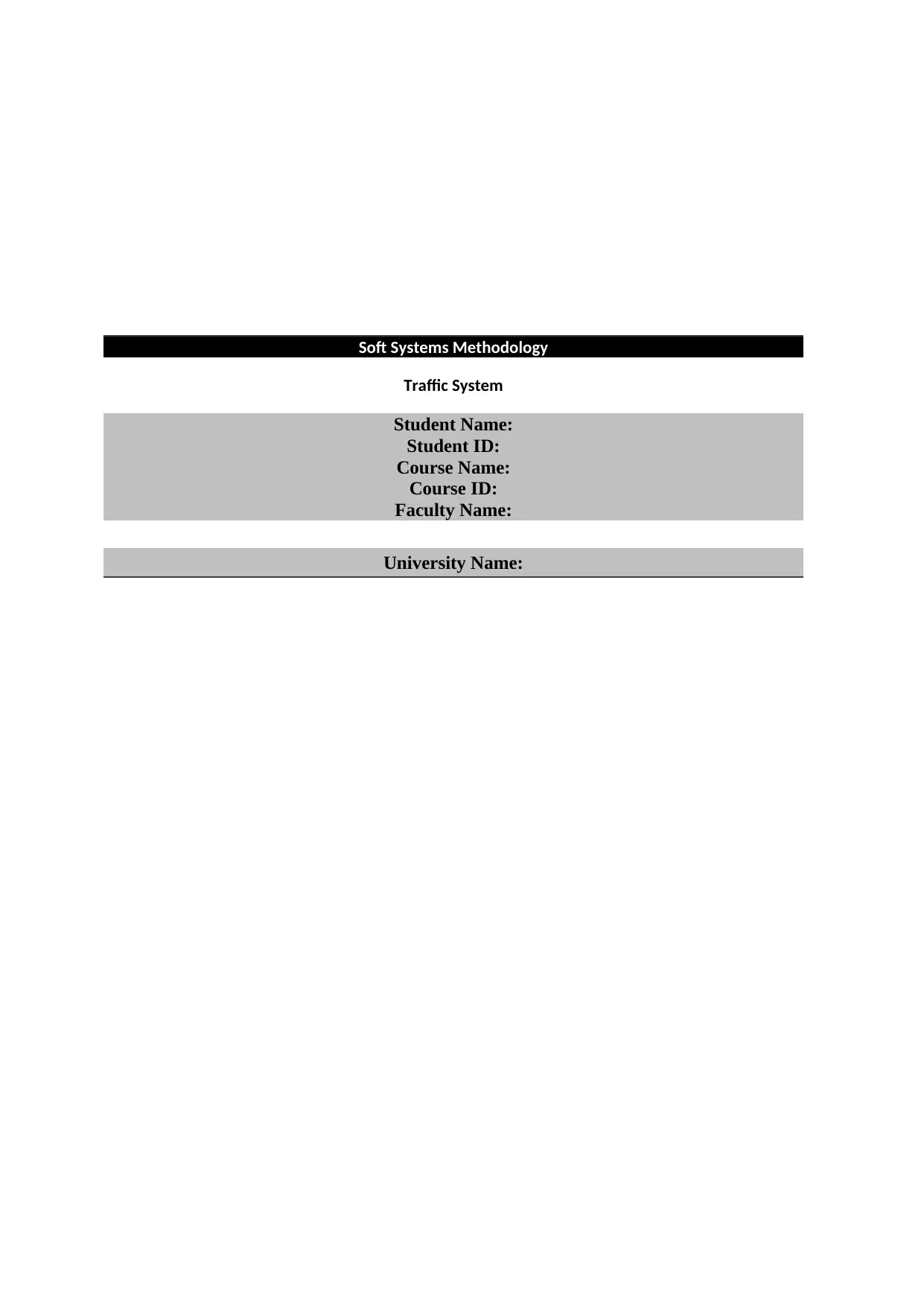
Soft Systems Methodology
Traffic System
Student Name:
Student ID:
Course Name:
Course ID:
Faculty Name:
University Name:
Traffic System
Student Name:
Student ID:
Course Name:
Course ID:
Faculty Name:
University Name:
Secure Best Marks with AI Grader
Need help grading? Try our AI Grader for instant feedback on your assignments.
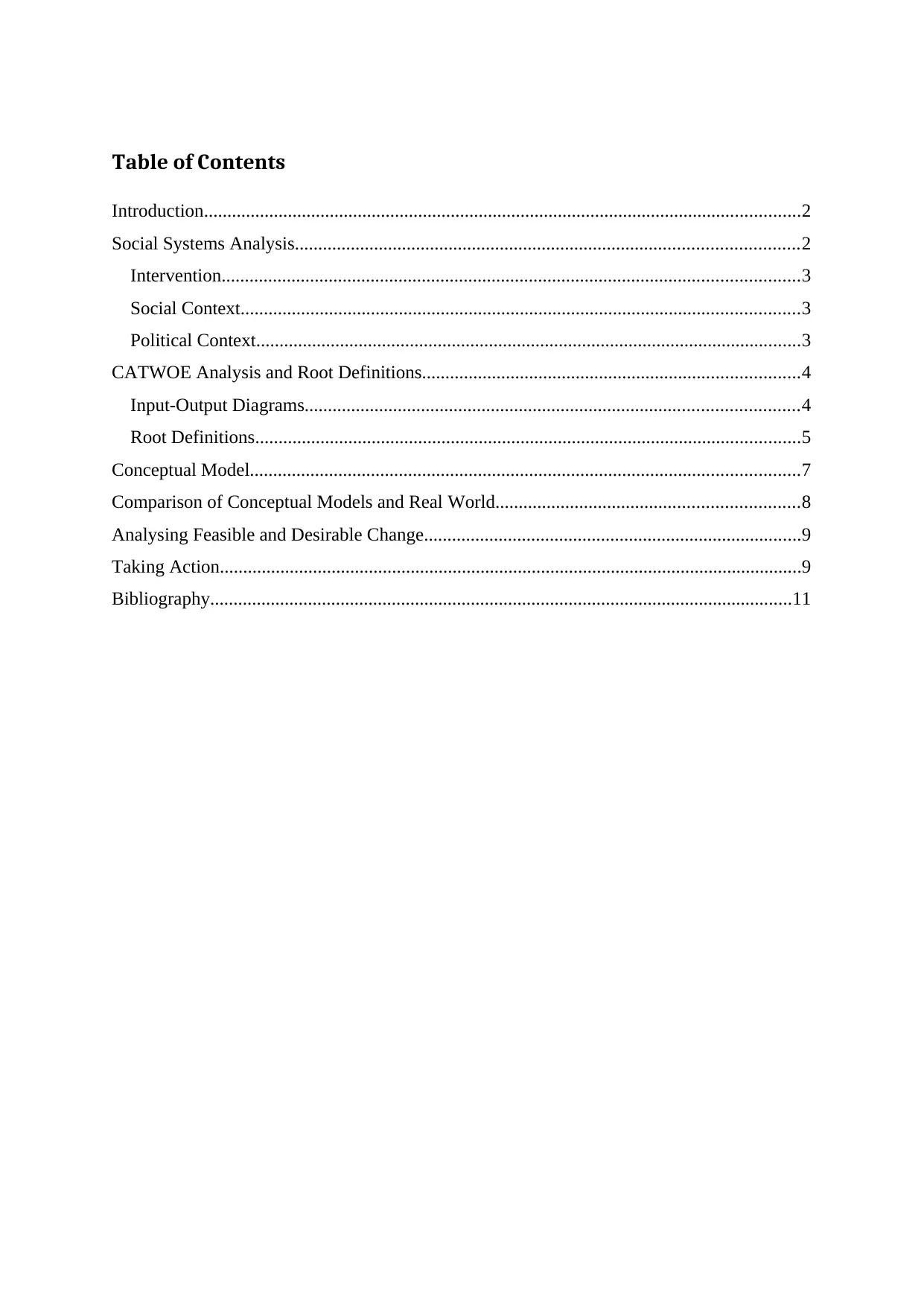
Table of Contents
Introduction................................................................................................................................2
Social Systems Analysis............................................................................................................2
Intervention............................................................................................................................3
Social Context........................................................................................................................3
Political Context.....................................................................................................................3
CATWOE Analysis and Root Definitions.................................................................................4
Input-Output Diagrams..........................................................................................................4
Root Definitions.....................................................................................................................5
Conceptual Model......................................................................................................................7
Comparison of Conceptual Models and Real World.................................................................8
Analysing Feasible and Desirable Change.................................................................................9
Taking Action.............................................................................................................................9
Bibliography.............................................................................................................................11
Introduction................................................................................................................................2
Social Systems Analysis............................................................................................................2
Intervention............................................................................................................................3
Social Context........................................................................................................................3
Political Context.....................................................................................................................3
CATWOE Analysis and Root Definitions.................................................................................4
Input-Output Diagrams..........................................................................................................4
Root Definitions.....................................................................................................................5
Conceptual Model......................................................................................................................7
Comparison of Conceptual Models and Real World.................................................................8
Analysing Feasible and Desirable Change.................................................................................9
Taking Action.............................................................................................................................9
Bibliography.............................................................................................................................11
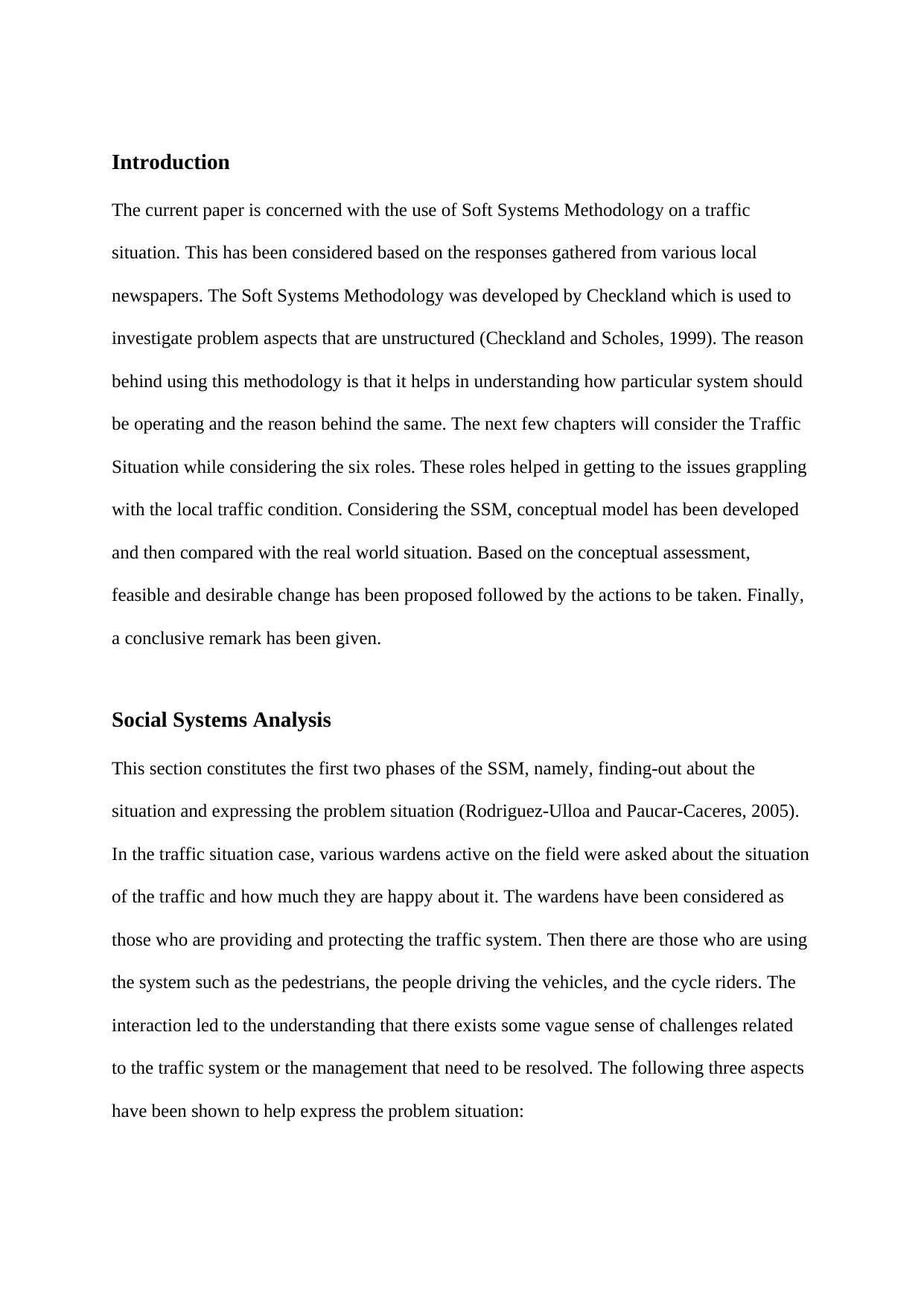
Introduction
The current paper is concerned with the use of Soft Systems Methodology on a traffic
situation. This has been considered based on the responses gathered from various local
newspapers. The Soft Systems Methodology was developed by Checkland which is used to
investigate problem aspects that are unstructured (Checkland and Scholes, 1999). The reason
behind using this methodology is that it helps in understanding how particular system should
be operating and the reason behind the same. The next few chapters will consider the Traffic
Situation while considering the six roles. These roles helped in getting to the issues grappling
with the local traffic condition. Considering the SSM, conceptual model has been developed
and then compared with the real world situation. Based on the conceptual assessment,
feasible and desirable change has been proposed followed by the actions to be taken. Finally,
a conclusive remark has been given.
Social Systems Analysis
This section constitutes the first two phases of the SSM, namely, finding-out about the
situation and expressing the problem situation (Rodriguez-Ulloa and Paucar-Caceres, 2005).
In the traffic situation case, various wardens active on the field were asked about the situation
of the traffic and how much they are happy about it. The wardens have been considered as
those who are providing and protecting the traffic system. Then there are those who are using
the system such as the pedestrians, the people driving the vehicles, and the cycle riders. The
interaction led to the understanding that there exists some vague sense of challenges related
to the traffic system or the management that need to be resolved. The following three aspects
have been shown to help express the problem situation:
The current paper is concerned with the use of Soft Systems Methodology on a traffic
situation. This has been considered based on the responses gathered from various local
newspapers. The Soft Systems Methodology was developed by Checkland which is used to
investigate problem aspects that are unstructured (Checkland and Scholes, 1999). The reason
behind using this methodology is that it helps in understanding how particular system should
be operating and the reason behind the same. The next few chapters will consider the Traffic
Situation while considering the six roles. These roles helped in getting to the issues grappling
with the local traffic condition. Considering the SSM, conceptual model has been developed
and then compared with the real world situation. Based on the conceptual assessment,
feasible and desirable change has been proposed followed by the actions to be taken. Finally,
a conclusive remark has been given.
Social Systems Analysis
This section constitutes the first two phases of the SSM, namely, finding-out about the
situation and expressing the problem situation (Rodriguez-Ulloa and Paucar-Caceres, 2005).
In the traffic situation case, various wardens active on the field were asked about the situation
of the traffic and how much they are happy about it. The wardens have been considered as
those who are providing and protecting the traffic system. Then there are those who are using
the system such as the pedestrians, the people driving the vehicles, and the cycle riders. The
interaction led to the understanding that there exists some vague sense of challenges related
to the traffic system or the management that need to be resolved. The following three aspects
have been shown to help express the problem situation:
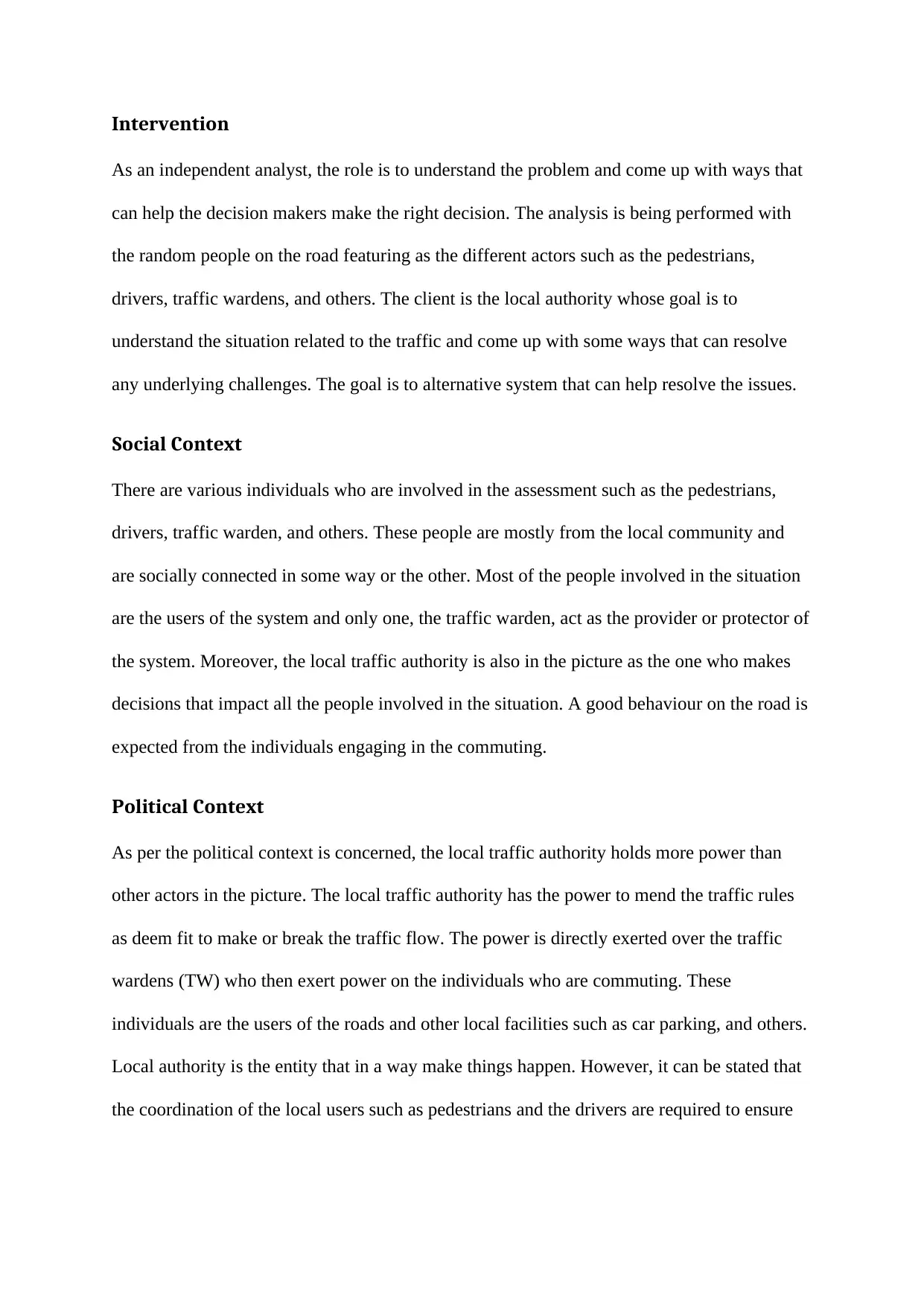
Intervention
As an independent analyst, the role is to understand the problem and come up with ways that
can help the decision makers make the right decision. The analysis is being performed with
the random people on the road featuring as the different actors such as the pedestrians,
drivers, traffic wardens, and others. The client is the local authority whose goal is to
understand the situation related to the traffic and come up with some ways that can resolve
any underlying challenges. The goal is to alternative system that can help resolve the issues.
Social Context
There are various individuals who are involved in the assessment such as the pedestrians,
drivers, traffic warden, and others. These people are mostly from the local community and
are socially connected in some way or the other. Most of the people involved in the situation
are the users of the system and only one, the traffic warden, act as the provider or protector of
the system. Moreover, the local traffic authority is also in the picture as the one who makes
decisions that impact all the people involved in the situation. A good behaviour on the road is
expected from the individuals engaging in the commuting.
Political Context
As per the political context is concerned, the local traffic authority holds more power than
other actors in the picture. The local traffic authority has the power to mend the traffic rules
as deem fit to make or break the traffic flow. The power is directly exerted over the traffic
wardens (TW) who then exert power on the individuals who are commuting. These
individuals are the users of the roads and other local facilities such as car parking, and others.
Local authority is the entity that in a way make things happen. However, it can be stated that
the coordination of the local users such as pedestrians and the drivers are required to ensure
As an independent analyst, the role is to understand the problem and come up with ways that
can help the decision makers make the right decision. The analysis is being performed with
the random people on the road featuring as the different actors such as the pedestrians,
drivers, traffic wardens, and others. The client is the local authority whose goal is to
understand the situation related to the traffic and come up with some ways that can resolve
any underlying challenges. The goal is to alternative system that can help resolve the issues.
Social Context
There are various individuals who are involved in the assessment such as the pedestrians,
drivers, traffic warden, and others. These people are mostly from the local community and
are socially connected in some way or the other. Most of the people involved in the situation
are the users of the system and only one, the traffic warden, act as the provider or protector of
the system. Moreover, the local traffic authority is also in the picture as the one who makes
decisions that impact all the people involved in the situation. A good behaviour on the road is
expected from the individuals engaging in the commuting.
Political Context
As per the political context is concerned, the local traffic authority holds more power than
other actors in the picture. The local traffic authority has the power to mend the traffic rules
as deem fit to make or break the traffic flow. The power is directly exerted over the traffic
wardens (TW) who then exert power on the individuals who are commuting. These
individuals are the users of the roads and other local facilities such as car parking, and others.
Local authority is the entity that in a way make things happen. However, it can be stated that
the coordination of the local users such as pedestrians and the drivers are required to ensure
Paraphrase This Document
Need a fresh take? Get an instant paraphrase of this document with our AI Paraphraser
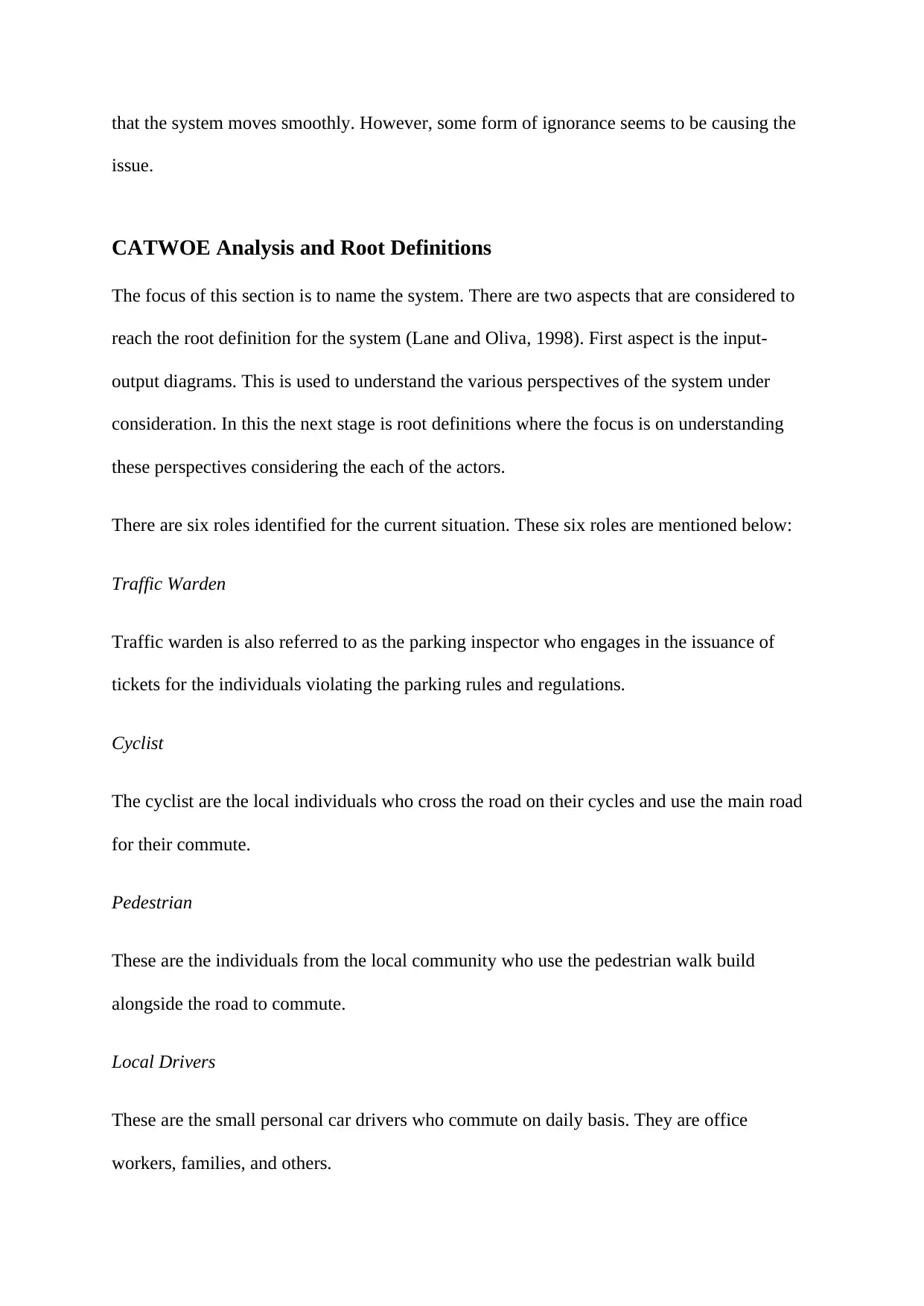
that the system moves smoothly. However, some form of ignorance seems to be causing the
issue.
CATWOE Analysis and Root Definitions
The focus of this section is to name the system. There are two aspects that are considered to
reach the root definition for the system (Lane and Oliva, 1998). First aspect is the input-
output diagrams. This is used to understand the various perspectives of the system under
consideration. In this the next stage is root definitions where the focus is on understanding
these perspectives considering the each of the actors.
There are six roles identified for the current situation. These six roles are mentioned below:
Traffic Warden
Traffic warden is also referred to as the parking inspector who engages in the issuance of
tickets for the individuals violating the parking rules and regulations.
Cyclist
The cyclist are the local individuals who cross the road on their cycles and use the main road
for their commute.
Pedestrian
These are the individuals from the local community who use the pedestrian walk build
alongside the road to commute.
Local Drivers
These are the small personal car drivers who commute on daily basis. They are office
workers, families, and others.
issue.
CATWOE Analysis and Root Definitions
The focus of this section is to name the system. There are two aspects that are considered to
reach the root definition for the system (Lane and Oliva, 1998). First aspect is the input-
output diagrams. This is used to understand the various perspectives of the system under
consideration. In this the next stage is root definitions where the focus is on understanding
these perspectives considering the each of the actors.
There are six roles identified for the current situation. These six roles are mentioned below:
Traffic Warden
Traffic warden is also referred to as the parking inspector who engages in the issuance of
tickets for the individuals violating the parking rules and regulations.
Cyclist
The cyclist are the local individuals who cross the road on their cycles and use the main road
for their commute.
Pedestrian
These are the individuals from the local community who use the pedestrian walk build
alongside the road to commute.
Local Drivers
These are the small personal car drivers who commute on daily basis. They are office
workers, families, and others.
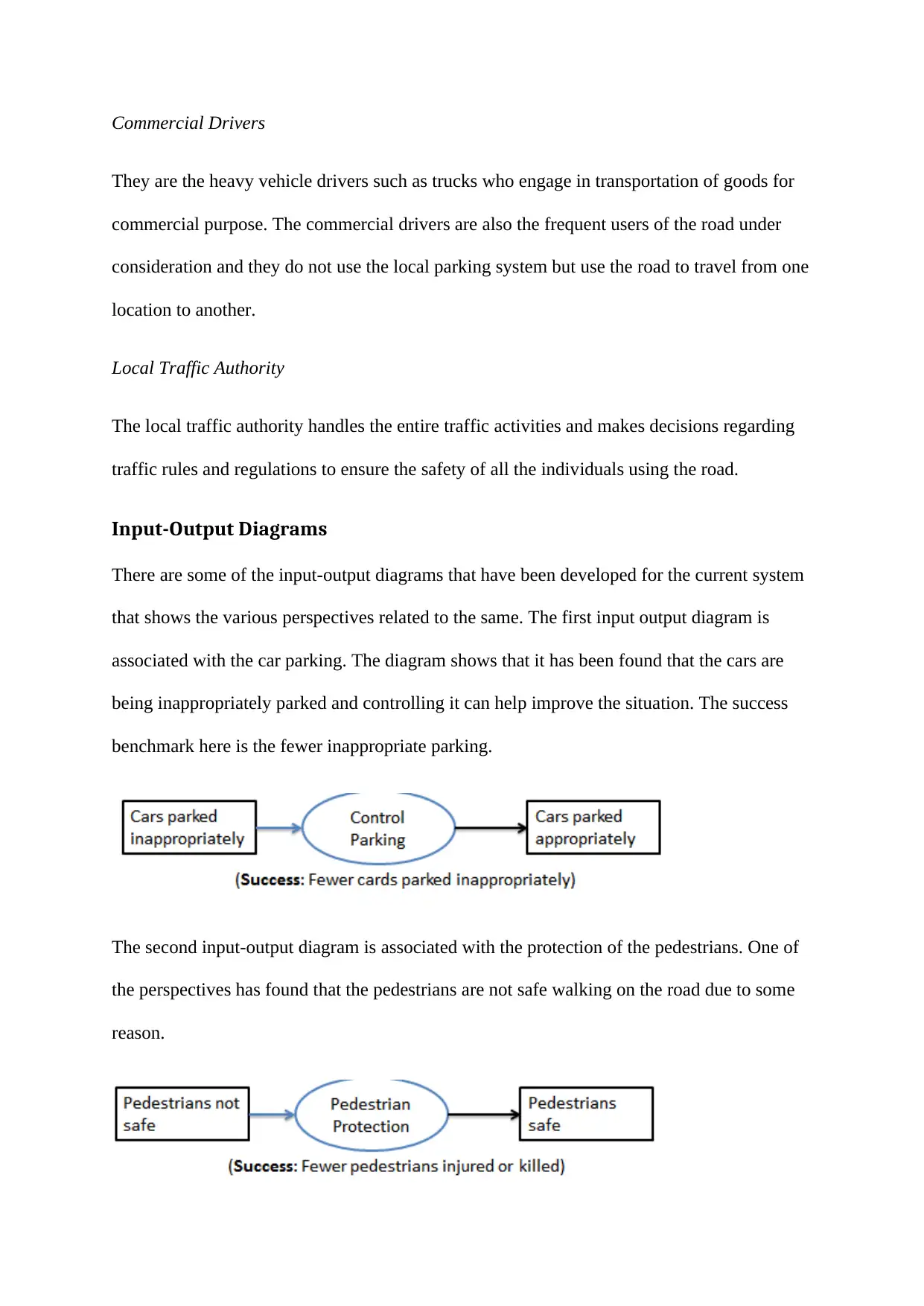
Commercial Drivers
They are the heavy vehicle drivers such as trucks who engage in transportation of goods for
commercial purpose. The commercial drivers are also the frequent users of the road under
consideration and they do not use the local parking system but use the road to travel from one
location to another.
Local Traffic Authority
The local traffic authority handles the entire traffic activities and makes decisions regarding
traffic rules and regulations to ensure the safety of all the individuals using the road.
Input-Output Diagrams
There are some of the input-output diagrams that have been developed for the current system
that shows the various perspectives related to the same. The first input output diagram is
associated with the car parking. The diagram shows that it has been found that the cars are
being inappropriately parked and controlling it can help improve the situation. The success
benchmark here is the fewer inappropriate parking.
The second input-output diagram is associated with the protection of the pedestrians. One of
the perspectives has found that the pedestrians are not safe walking on the road due to some
reason.
They are the heavy vehicle drivers such as trucks who engage in transportation of goods for
commercial purpose. The commercial drivers are also the frequent users of the road under
consideration and they do not use the local parking system but use the road to travel from one
location to another.
Local Traffic Authority
The local traffic authority handles the entire traffic activities and makes decisions regarding
traffic rules and regulations to ensure the safety of all the individuals using the road.
Input-Output Diagrams
There are some of the input-output diagrams that have been developed for the current system
that shows the various perspectives related to the same. The first input output diagram is
associated with the car parking. The diagram shows that it has been found that the cars are
being inappropriately parked and controlling it can help improve the situation. The success
benchmark here is the fewer inappropriate parking.
The second input-output diagram is associated with the protection of the pedestrians. One of
the perspectives has found that the pedestrians are not safe walking on the road due to some
reason.
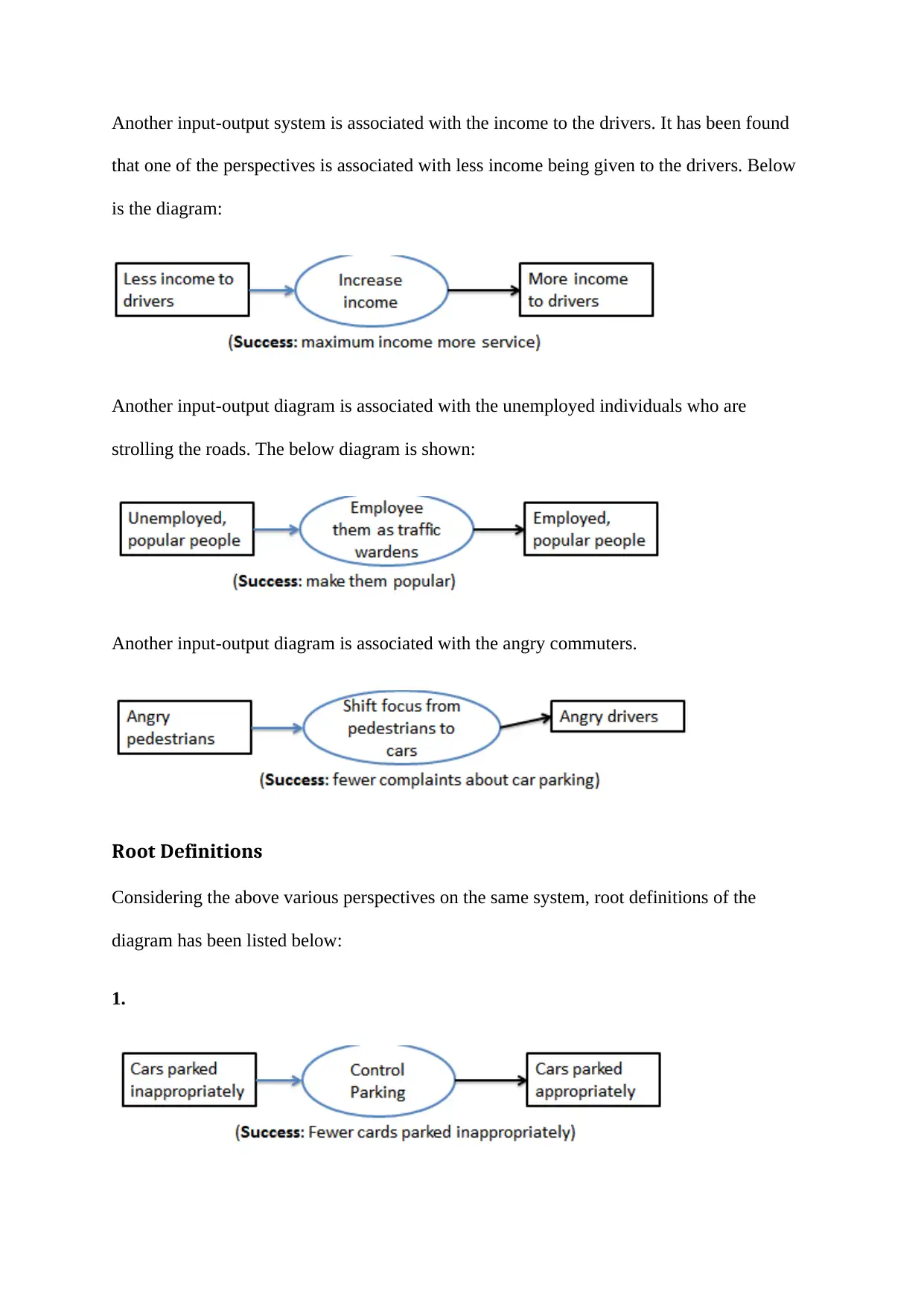
Another input-output system is associated with the income to the drivers. It has been found
that one of the perspectives is associated with less income being given to the drivers. Below
is the diagram:
Another input-output diagram is associated with the unemployed individuals who are
strolling the roads. The below diagram is shown:
Another input-output diagram is associated with the angry commuters.
Root Definitions
Considering the above various perspectives on the same system, root definitions of the
diagram has been listed below:
1.
that one of the perspectives is associated with less income being given to the drivers. Below
is the diagram:
Another input-output diagram is associated with the unemployed individuals who are
strolling the roads. The below diagram is shown:
Another input-output diagram is associated with the angry commuters.
Root Definitions
Considering the above various perspectives on the same system, root definitions of the
diagram has been listed below:
1.
Secure Best Marks with AI Grader
Need help grading? Try our AI Grader for instant feedback on your assignments.
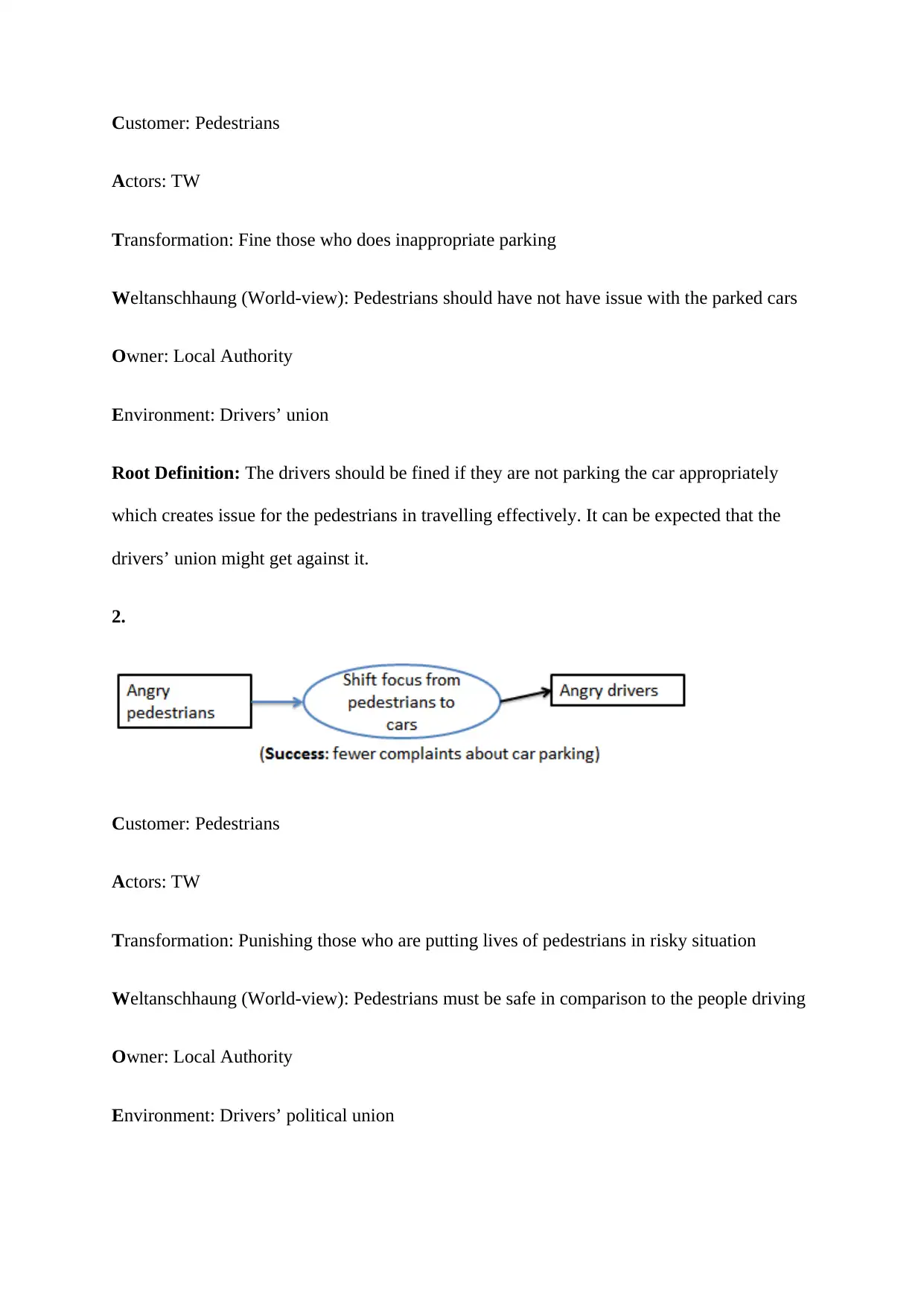
Customer: Pedestrians
Actors: TW
Transformation: Fine those who does inappropriate parking
Weltanschhaung (World-view): Pedestrians should have not have issue with the parked cars
Owner: Local Authority
Environment: Drivers’ union
Root Definition: The drivers should be fined if they are not parking the car appropriately
which creates issue for the pedestrians in travelling effectively. It can be expected that the
drivers’ union might get against it.
2.
Customer: Pedestrians
Actors: TW
Transformation: Punishing those who are putting lives of pedestrians in risky situation
Weltanschhaung (World-view): Pedestrians must be safe in comparison to the people driving
Owner: Local Authority
Environment: Drivers’ political union
Actors: TW
Transformation: Fine those who does inappropriate parking
Weltanschhaung (World-view): Pedestrians should have not have issue with the parked cars
Owner: Local Authority
Environment: Drivers’ union
Root Definition: The drivers should be fined if they are not parking the car appropriately
which creates issue for the pedestrians in travelling effectively. It can be expected that the
drivers’ union might get against it.
2.
Customer: Pedestrians
Actors: TW
Transformation: Punishing those who are putting lives of pedestrians in risky situation
Weltanschhaung (World-view): Pedestrians must be safe in comparison to the people driving
Owner: Local Authority
Environment: Drivers’ political union
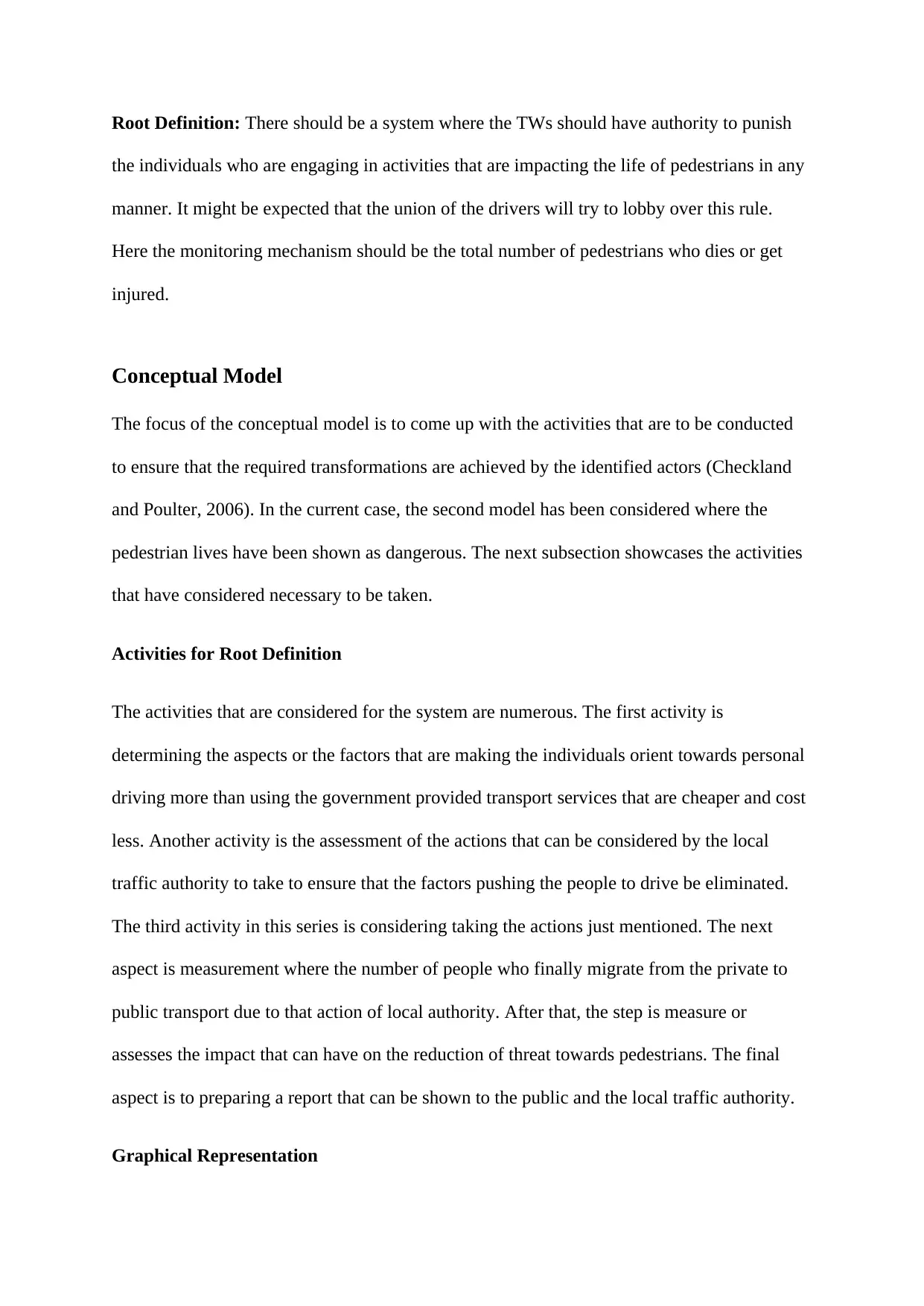
Root Definition: There should be a system where the TWs should have authority to punish
the individuals who are engaging in activities that are impacting the life of pedestrians in any
manner. It might be expected that the union of the drivers will try to lobby over this rule.
Here the monitoring mechanism should be the total number of pedestrians who dies or get
injured.
Conceptual Model
The focus of the conceptual model is to come up with the activities that are to be conducted
to ensure that the required transformations are achieved by the identified actors (Checkland
and Poulter, 2006). In the current case, the second model has been considered where the
pedestrian lives have been shown as dangerous. The next subsection showcases the activities
that have considered necessary to be taken.
Activities for Root Definition
The activities that are considered for the system are numerous. The first activity is
determining the aspects or the factors that are making the individuals orient towards personal
driving more than using the government provided transport services that are cheaper and cost
less. Another activity is the assessment of the actions that can be considered by the local
traffic authority to take to ensure that the factors pushing the people to drive be eliminated.
The third activity in this series is considering taking the actions just mentioned. The next
aspect is measurement where the number of people who finally migrate from the private to
public transport due to that action of local authority. After that, the step is measure or
assesses the impact that can have on the reduction of threat towards pedestrians. The final
aspect is to preparing a report that can be shown to the public and the local traffic authority.
Graphical Representation
the individuals who are engaging in activities that are impacting the life of pedestrians in any
manner. It might be expected that the union of the drivers will try to lobby over this rule.
Here the monitoring mechanism should be the total number of pedestrians who dies or get
injured.
Conceptual Model
The focus of the conceptual model is to come up with the activities that are to be conducted
to ensure that the required transformations are achieved by the identified actors (Checkland
and Poulter, 2006). In the current case, the second model has been considered where the
pedestrian lives have been shown as dangerous. The next subsection showcases the activities
that have considered necessary to be taken.
Activities for Root Definition
The activities that are considered for the system are numerous. The first activity is
determining the aspects or the factors that are making the individuals orient towards personal
driving more than using the government provided transport services that are cheaper and cost
less. Another activity is the assessment of the actions that can be considered by the local
traffic authority to take to ensure that the factors pushing the people to drive be eliminated.
The third activity in this series is considering taking the actions just mentioned. The next
aspect is measurement where the number of people who finally migrate from the private to
public transport due to that action of local authority. After that, the step is measure or
assesses the impact that can have on the reduction of threat towards pedestrians. The final
aspect is to preparing a report that can be shown to the public and the local traffic authority.
Graphical Representation

The diagram below shows the conceptual model that has been developed. It shows the input
to the system that finally converts into the system output but not before getting processed
through various parameters such as assessment, measurement and reporting.
Here, it should be noted that there are two elements that press towards monitoring. The first
aspect is internal that focus on measurement of the actions of the local authority. The
individuals engaging in measurement can be successfully benefited if the appropriate
feedback mechanism is established for the measurement. On the other hand, another
monitoring system is external which is management related. The focus of this monitoring is
to understand that whether the new system that was implemented has been a success. Both
the aspects have been considered important assuming that the internal activities will provide
ground level improvement and the external system will help in the overall assessment and
provide long term meaningful feedback.
Comparison of Conceptual Models and Real World
The comparison of the conceptual model and the real world is being considered in this
section. The first aspect is related to the determination of the factors that are contributing as
the support for the people to prefer driving over public transport. Here, the real world
to the system that finally converts into the system output but not before getting processed
through various parameters such as assessment, measurement and reporting.
Here, it should be noted that there are two elements that press towards monitoring. The first
aspect is internal that focus on measurement of the actions of the local authority. The
individuals engaging in measurement can be successfully benefited if the appropriate
feedback mechanism is established for the measurement. On the other hand, another
monitoring system is external which is management related. The focus of this monitoring is
to understand that whether the new system that was implemented has been a success. Both
the aspects have been considered important assuming that the internal activities will provide
ground level improvement and the external system will help in the overall assessment and
provide long term meaningful feedback.
Comparison of Conceptual Models and Real World
The comparison of the conceptual model and the real world is being considered in this
section. The first aspect is related to the determination of the factors that are contributing as
the support for the people to prefer driving over public transport. Here, the real world
Paraphrase This Document
Need a fresh take? Get an instant paraphrase of this document with our AI Paraphraser
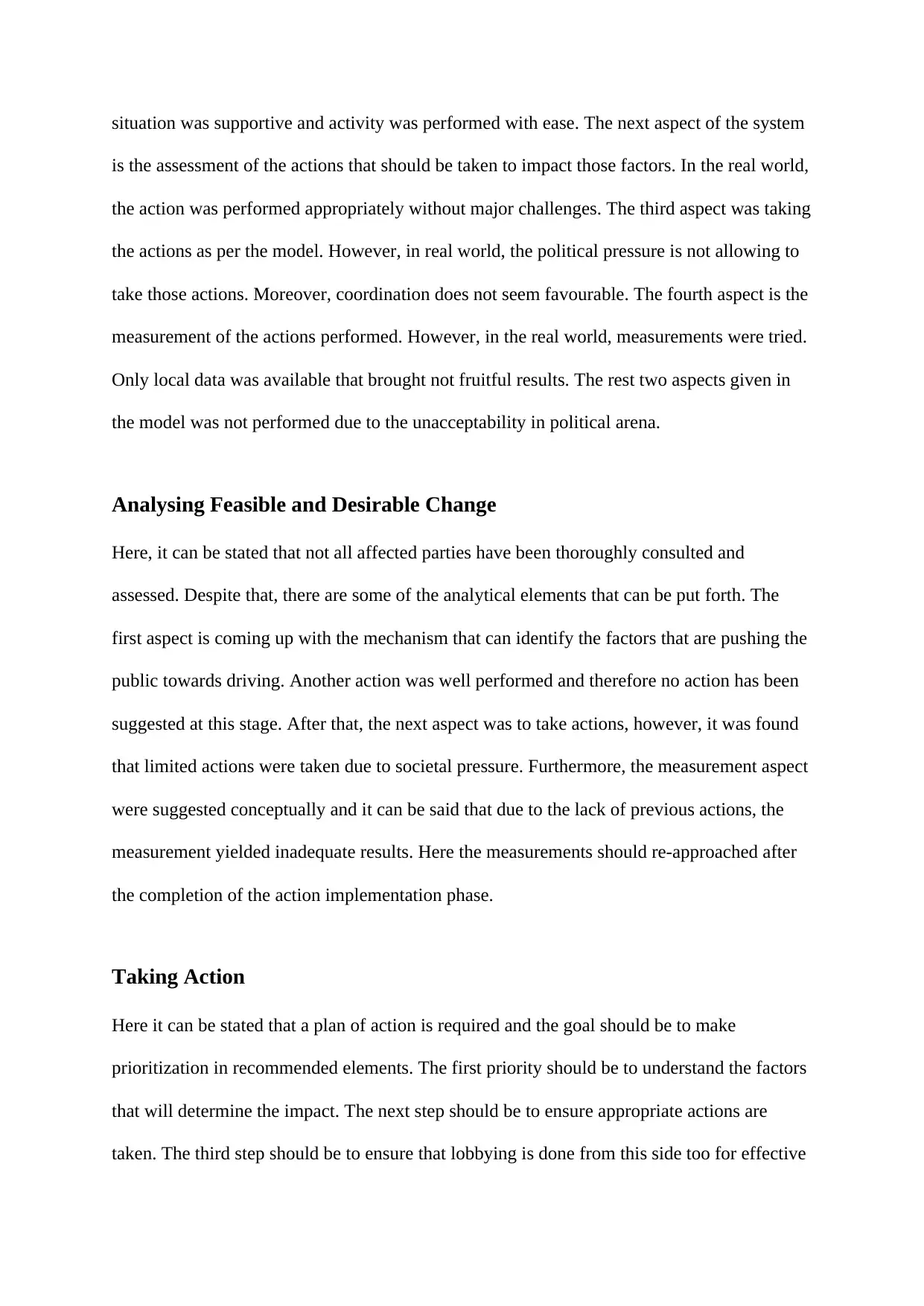
situation was supportive and activity was performed with ease. The next aspect of the system
is the assessment of the actions that should be taken to impact those factors. In the real world,
the action was performed appropriately without major challenges. The third aspect was taking
the actions as per the model. However, in real world, the political pressure is not allowing to
take those actions. Moreover, coordination does not seem favourable. The fourth aspect is the
measurement of the actions performed. However, in the real world, measurements were tried.
Only local data was available that brought not fruitful results. The rest two aspects given in
the model was not performed due to the unacceptability in political arena.
Analysing Feasible and Desirable Change
Here, it can be stated that not all affected parties have been thoroughly consulted and
assessed. Despite that, there are some of the analytical elements that can be put forth. The
first aspect is coming up with the mechanism that can identify the factors that are pushing the
public towards driving. Another action was well performed and therefore no action has been
suggested at this stage. After that, the next aspect was to take actions, however, it was found
that limited actions were taken due to societal pressure. Furthermore, the measurement aspect
were suggested conceptually and it can be said that due to the lack of previous actions, the
measurement yielded inadequate results. Here the measurements should re-approached after
the completion of the action implementation phase.
Taking Action
Here it can be stated that a plan of action is required and the goal should be to make
prioritization in recommended elements. The first priority should be to understand the factors
that will determine the impact. The next step should be to ensure appropriate actions are
taken. The third step should be to ensure that lobbying is done from this side too for effective
is the assessment of the actions that should be taken to impact those factors. In the real world,
the action was performed appropriately without major challenges. The third aspect was taking
the actions as per the model. However, in real world, the political pressure is not allowing to
take those actions. Moreover, coordination does not seem favourable. The fourth aspect is the
measurement of the actions performed. However, in the real world, measurements were tried.
Only local data was available that brought not fruitful results. The rest two aspects given in
the model was not performed due to the unacceptability in political arena.
Analysing Feasible and Desirable Change
Here, it can be stated that not all affected parties have been thoroughly consulted and
assessed. Despite that, there are some of the analytical elements that can be put forth. The
first aspect is coming up with the mechanism that can identify the factors that are pushing the
public towards driving. Another action was well performed and therefore no action has been
suggested at this stage. After that, the next aspect was to take actions, however, it was found
that limited actions were taken due to societal pressure. Furthermore, the measurement aspect
were suggested conceptually and it can be said that due to the lack of previous actions, the
measurement yielded inadequate results. Here the measurements should re-approached after
the completion of the action implementation phase.
Taking Action
Here it can be stated that a plan of action is required and the goal should be to make
prioritization in recommended elements. The first priority should be to understand the factors
that will determine the impact. The next step should be to ensure appropriate actions are
taken. The third step should be to ensure that lobbying is done from this side too for effective

measurement. Overall, it can be stated that the Soft Systems Methodology is an appropriate
method that helps understand the unstructured system and make recommendations as
required (Bermúdez et al, 2006). The system here for the example has been the traffic where
the actors were traffic warden, local authority, pedestrians, drivers, and others.
method that helps understand the unstructured system and make recommendations as
required (Bermúdez et al, 2006). The system here for the example has been the traffic where
the actors were traffic warden, local authority, pedestrians, drivers, and others.

Bibliography
Bermúdez, J.D., Segura, J.V. and Vercher, E., 2006. A decision support system methodology
for forecasting of time series based on soft computing. Computational statistics & data
analysis, 51(1), pp.177-191.
Checkland, P. and Poulter, J., 2006. Learning for action: a short definitive account of soft
systems methodology and its use for practitioner, teachers, and students (Vol. 26).
Chichester: Wiley.
Checkland, P. and Scholes, J., 1999. Soft systems methodology: a 30-year retrospective (pp.
330-pages). Chichester: John Wiley.
Lane, D.C. and Oliva, R., 1998. The greater whole: Towards a synthesis of system dynamics
and soft systems methodology. European Journal of Operational Research, 107(1), pp.214-
235.
Rodriguez-Ulloa, R. and Paucar-Caceres, A., 2005. Soft system dynamics methodology
(SSDM): combining soft systems methodology (SSM) and system dynamics (SD). Systemic
Practice and Action Research, 18(3), pp.303-334.
Bermúdez, J.D., Segura, J.V. and Vercher, E., 2006. A decision support system methodology
for forecasting of time series based on soft computing. Computational statistics & data
analysis, 51(1), pp.177-191.
Checkland, P. and Poulter, J., 2006. Learning for action: a short definitive account of soft
systems methodology and its use for practitioner, teachers, and students (Vol. 26).
Chichester: Wiley.
Checkland, P. and Scholes, J., 1999. Soft systems methodology: a 30-year retrospective (pp.
330-pages). Chichester: John Wiley.
Lane, D.C. and Oliva, R., 1998. The greater whole: Towards a synthesis of system dynamics
and soft systems methodology. European Journal of Operational Research, 107(1), pp.214-
235.
Rodriguez-Ulloa, R. and Paucar-Caceres, A., 2005. Soft system dynamics methodology
(SSDM): combining soft systems methodology (SSM) and system dynamics (SD). Systemic
Practice and Action Research, 18(3), pp.303-334.
1 out of 13
Related Documents
Your All-in-One AI-Powered Toolkit for Academic Success.
+13062052269
info@desklib.com
Available 24*7 on WhatsApp / Email
![[object Object]](/_next/static/media/star-bottom.7253800d.svg)
Unlock your academic potential
© 2024 | Zucol Services PVT LTD | All rights reserved.





